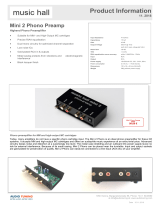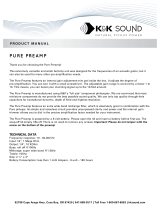Page is loading ...

1020B
Stereo Preamplifier
Date of manufacture : Jan 85 - Jan 87
Please note that this document contains the text from the original product brochure, and some technical statements may now be out of date
The NAD 1020B continues the NAD tradition of remarkable price/performance value. An audiophile-quality
preamplifier at an extraordinarily low price, the NAD 1020B is derived from the design of the pre-amp section in the
renowned NAD 3020B integrated amplifier. It is the optimum choice for listeners who wish to combine the
simplicity and acclaimed performance of the 3020B with a much larger power amplifier, a bi-amplified system, or
active powered loudspeakers. The surprisingly low price of the NAD 1020B pre-amp, together with the modest cost
of several “best buy” power amplifiers in today’s marketplace, substantially reduces the entry cost into high-
performance separates for many audiophiles whose choice would otherwise be limited to integrated amplifiers and
receivers. Do not be deceived by the 1020B’s external simplicity and bargain cost; this is not a compromise product,
nor a halfway step toward high-quality sound. Its economy results from spartan cosmetics, canny engineering,,
efficient manufacturing, modest input/output flexibility, and the elimination of seldom- used features. Behind its
modest faceplate the 1020B’s circuitry-and its sonic performance-are the equal of most preamplifiers costing two or
three times more, Circuit Features Wide-Range Phono Preamplifier. As long as phonograph records remain the
primary high-quality music source for most listeners, the phono pre-amp stage will be the heart of any good
preamplifier-its most important circuit and potentially its weakest link.
Instead of the usual low-cost IC, the phono preamplifier section of the 1020B is a newly designed discrete-transistor
circuit whose performance matches that of far more expensive pre-amp systems: 0 It interfaces correctly with the
high impedance of the moving-magnet pickup cartridge (as many costlier preamplifiers do not), avoiding complex
impedance interactions that can alter the pickup’s frequency response.
• Its input capacitance is switch-selectable, allowing you to provide the loading that the cartridge needs for flattest
response.
• its precise RIAA equalisation preserves the exact frequency response of your cartridge.
• Its signal to noise ratio is optimised, not for the usual short-circuit input, but for the typical impedance of real
magnetic cartridges. As a result its residual circuit noise is close to the theoretical limit set by the cartridge itself
(the “thermal” noise due to the pickup’s own impedance). This ensures that the preamp’s noise will be inaudible
even when you are playing the widest-range direct-to-disc and digitally mastered discs.
• For low-output moving-coil cartridges a rear-panel switch resets the preamp’s parameters to provide the required
20 dB of added gain with extremely low noise-lower than that of many external pre-preamplifiers, while
avoiding the high cost and hum problems of step-up transformers.
• The circuit’s distortion remains extremely low, not only with simple sine-wave test tones but also when
reproducing the most complex and demanding high-level waveforms that a cartridge can generate. The circuit’s
output stage has ample headroom for the amplified musical waveform and also provides plenty of current to
drive the reactive RIAA feed-back network without strain.
• The dynamic range of the phono stage, over 107 dB, is ample for the widest-range digitally mastered recordings.

Infrasonic Filtering
In a laboratory, response down to DC and up to frequencies in the megahertz range may be ideal, but in real-world
environments the musical signal often is contaminated by interference at frequencies below and above the audible
range: turntable rumble, floor vibration, tonearm/stylus resonance, radio interference. Such extraneous signals can
impair an amplifier’s handling of musical sound, waste amplifier power and woofer cone excursion, and contribute
to audible intermodulation distortion in loud-speakers.
The precise, minimum-phase, audio bandpass filtering in the NAD 1020B strips off such interference while
preserving accurate response at audible frequencies, ensuring the cleanest possible amplification of the musical
signal.
Musically Useful Tone Controls
Among some pre-amp designers it has become fashionable to omit tone controls. But tone controls are a genuinely
helpful aid to enjoyable music listening, as long as they are correctly designed-meaning that they must not add
audible distortion or noise, and must not alter the basic tonal balance in the critical midrange. In the NAD 1020B
the Bass and Treble controls have been designed so that, at moderate boost/cut settings, they provide musically
useful corrections at very low and high frequencies while the midrange from 300 to 1500 Hz remains essentially
flat. Since high circuit impedances often add a subtle veil of noise to reproduced sound, the 1020B employs a high-
current tone control amplifier stage with low impedances throughout.
Digital-Ready Dynamic Range
To use a pure-digital disc player, just connect its line-level outputs to the 1020B’s AUX inputs, and play. The 1020B’s
AUX and TAPE inputs cannot be overloaded by high-level signal peaks, and the 1020B’s signal to noise ratio exceeds
that of the widest-range digital recording systems.
High Current Output Buffer
In addition to its conventional pre-amp outputs the 1020B has a high-current output stage (a miniature power
amplifier circuit) that can produce output signals of up to 15 volts with low output impedance.
These signals are fed both to the front-panel headphones jack and to an extra set of “high level” pre-amp output
jacks on the rear panel. With this circuit the 1020B can drive virtually all non-electrostatic headphones, even low-
sensitivity models, to full output. And with its low 150-ohm output impedance it can easily drive several power
amplifiers in parallel, drive professional 600-ohm studio equipment, or drive the long connecting cables required for
active powered loud-speakers or for remotely located power amplifiers.
Designed for Value
NAD stereo components have been praised around the world for their unusual combination of modest price,
uncomplicated controls, advanced engineering, and state-of-the-art sonic performance. The NAD 1020B
preamplifier is squarely in that tradition. For accuracy, for freedom from noise and distortion, for transparent and
supremely musical sound quality, the 1020B is unmatched in value.

PRE-AMP SECTION
Phono input
Input impedance
(R and C) MM & MC 47kΩ / 100, 200 or 320pF
Input sensitivity, 1kHz MM 1.25mV ref. 0.5V
MC 0.09mV
Input overload at 20Hz / 1kHz / 20kHz 20 / 200 / 1800mV
Signal/Noise ratio
(A-weighted with cartridge connected) MM 75dB ref. 5mV
MC 72dB ref. 0.5mV
RIAA response accuracy MM ±0.5dB
(20Hz - 20kHz)
MC ±0.5dB (50Hz - 20kHz)
Line level inputs
Input impedance
(R and C) 20kΩ / 220pF
Input sensitivity ref. 0.5V 80mV
Maximum input signal >25V
Signal/Noise ratio
(A-weighted ref 0.5V) 94dB
Frequency response ±0.5dB
Line level outputs
Output impedance Pre-amp 600Ω
Tape Source Z + 1kΩ
Phones 150Ω
Maximum output level Pre-amp >15V
Tape >10V
Phones >5V into 600Ω
>250mV into 8Ω
Remote No
NAD Link No
PHYSICAL SPECIFICATIONS
Dimensions (W x H x D) 420 x 96 x 240mm
Net weight 3.7kg
Shipping weight 4.8kg
Power consumption (120 ~ 240V, 50/60Hz) 5W
Dimensions are of unit’s cabinet without attached feet; add up to 18mm for total height.
Dimension depth excludes terminals, sockets, controls and buttons.
© NAD Electronics. All rights reserved. E & OE
/

